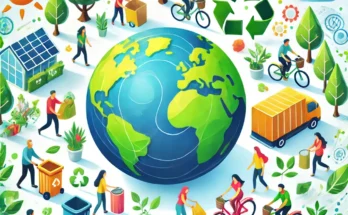How Sustainable Practices Can Safeguard Our Planet’s Future:
INTRODUCTION
When one looks into the face of the crises facing the environment-from rising temperatures straight to dwindling resources-then, there can be no dismissal of the plight facing the entire global community; however, in all these growing crises, against the determination of the forces promoting the status quo, the opposite stream is forming-a movement toward sustainability. This is very much such that it must provide an avenue Shaping Tomorrow for future generations to survive on earth. But what, really, is sustainability, and how do individual citizens, industries, and nations affect that effort? Here is an exposition of sustainabilityism as it stands today, with a keen focus on its urgent importance and how we should respond towards the pressing need to save the planet while we still have the chance.
Definition of Sustainability: A Plan for the Future
Sustainability can be best understood simply as meeting present needs while not compromising the ability of future generations to meet their own needs. Some balance is expected between resource use, pollution creation, and the maintenance of the systems that support life on Earth. Sustainability is not only for the environment; it also involves the economy and the society. Thus, we must struggle for a full-fledged approach to development that respects the earth and its inhabitants.
Sustainable development is moving away from whatever eroded one’s environment: where mining takes away natural resources that are hardly replaceable or where whatever becomes poison to the environment. Rather, this will develop practices that will offer ecological restoration, sustaining and fishing for ecological betterment, enabling our activities to continue meeting our needs without endangering or exhausting the earth’s inheritance.
The Power of Each: Small Change for Huge Impact
While necessary, large-scale changes in industry must work hand in hand with the influence of the individual on environmental conservation. Each day, everything from how one prepares food to which form of energy one uses challenges the modern person with ecological destruction. Small sustainable changes can have a major impact on the environment as a whole.
A small example: all daily decisions that reduce one’s footprint would come from a little plastic use, not wasting water, taking public transport, or wasting less food. On the other hand, moving on to sustainable products and services generally comes from switching to energy-efficient appliances, plant-based food, and safe packaging-this can do too much to lessen the demands of devilish practices on nature.
Perhaps most critically, these individual actions will further inspire others. As citizens touch upon sustainability as a real course of action, millions of small changes eventually become the ripple effect, compelling businesses and policymakers to take a real stand for a greener future.
Technology and Innovation: The Key to Sustainable Development
Yet there is no overemphasizing the contribution technology makes to the promotion of sustainability: innovations in renewable energy, sustainable agriculture, and waste management are set to change profoundly our relationship with the Earth.
Examples of such renewables include solar and wind technologies, which have raised the bar significantly. With greater efficiency and lower cost of generation, they are prepared to take share from fossil fuel alternatives in the energy mix. Other battery storage developments cover the stochasticity of renewable power, augmenting to a more reliable platform for the distribution grid.
Vertical and precision agriculture and organic practices are examples of climate-smart agriculture that will enhance food production while at the same time reducing waste, conserving water, and shrinking the overall carbon agricultural footprint. Recycling technologies are transforming waste management. This ensures a decline in the use of landfills and also diminishes gaseous emissions.
Firms that are now about to enter into the innovations and the technologies will proceed toward the environment by taking them as green entrepreneurs positioned within the profit lead of the emergent economy.
Corporate Responsibility: A Turning Point for Industries
While individual actions will be important, it is the functions of corporations and industries that will have the most far-reaching and lasting environmental impact. Corporations can be a major contributor to environmental destruction as well as an ally for an ecological outcome.
Corporate sustainability is in direct response to growing public demand for ecological practices. All industries, from that of fashion to technology, are moving quickly to implement sustainable practices throughout their operations: some are reducing carbon emissions; some are moving toward circular economies; some are responsibly sourcing raw materials. The shift has come about as consumer awareness of environmental stewardship became an immense factor.
While the demand is driven by consumers, in recent times it has become necessary for governments to take steps to develop stringent standards for industries to comply with. As a result, there is now a move toward creating a settings that has established sustainability as not just ethical business policy, but also as business savvy. Companies investing in sustainability will not only be reducing their environmental impact, but also “future-proofing” themselves against the multiplier risks that climate change and resource scarcity pose.
Role of Policy: Coordinated Global Action
Effective environmental solutions must be implemented in a coordinated, global effort. National and international policies frame in norms of sustainability. Whereas international agreements like the Paris Agreement impose an obligation to reduce carbon emissions for limiting global warming, local policies may willingly stimulate the use of renewable energy, promote green investments, and promulgate codes of practice banning harmful pursuits.
Policies are not enough. The governments should join with NGOs, scientists, businesses, and communities for strategic planning and execution of solutions. Sustainable development must cut across different levels of governance, from local municipalities to global bodies, assuring that characterized decisions taken today will contribute to environmental sustainability for many decades into the future.
Conclusion: Now is the Time to Act
The environment is facing some unprecedented challenges at present, but the light of hope is still not extinguished. Sustainability is not an aspiration to realize at some undefined, impossible time in the future; it is a practical and achievable goal which we can work for now. The individual, the business, and the country could act to restore the planet to a more resilient and sustainable one.
Sustainability demands collaboration, innovation, and, above all, urgency. It is the decisions we make today that will determine our choices for tomorrow, whether those choices come across through political participation, business leadership, or private choice. Now is the time to act toward putting the notion of a greener tomorrow into reality.
Final Conclusion: Sustainability as a Legacy Passed to Future Generations
Sustainability is not just a fad or a trend; it is the foundation on which the future of the planet, together with every creature living on it, will be built. It will ensure that we wish away our indiscretions with reference to the non-renewable resources and biodiversity, thereby establishing a balance between human development and the environment. It is not just an obligation but a golden chance to bequeath the ultimate legacy of stewardship, innovation, and respect for the planet.



